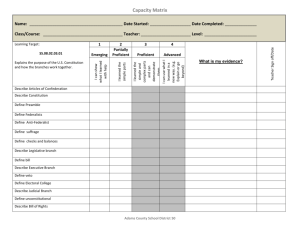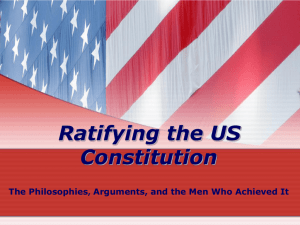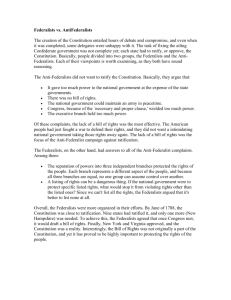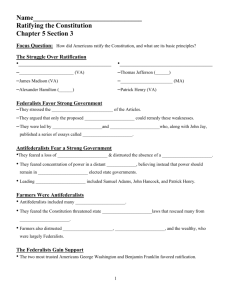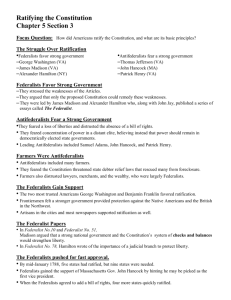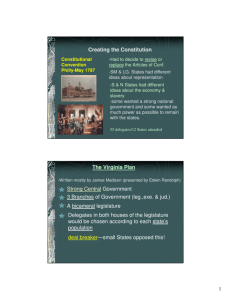Lesson 8.3: Ratifying the Constitution
advertisement
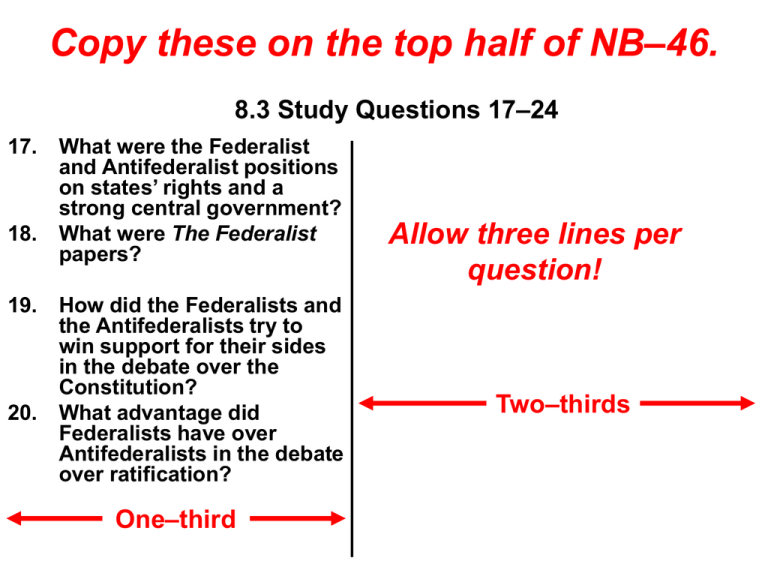
Copy these on the top half of NB–46. 8.3 Study Questions 17–24 17. 18. 19. 20. What were the Federalist and Antifederalist positions on states’ rights and a strong central government? What were The Federalist papers? How did the Federalists and the Antifederalists try to win support for their sides in the debate over the Constitution? What advantage did Federalists have over Antifederalists in the debate over ratification? One–third Allow three lines per question! Two–thirds Copy these on the bottom half of NB-46. 21. 22. 23. 24. Why did George Mason and Patrick Henry oppose the ratification of the new constitution? What is the Bill of Rights? What was the significance of the Bill of Rights? How is Jefferson’s Statute for Religious Freedom reflected in the Bill of Rights? One–third Allow three lines per question! Two–thirds Draw the following on NB p. 42. Federalism – (allow 2 lines for a definition) 1. What were Federalists? 2. What were Antifederalists? 3. Who were the leading Federalists? 4. Who were the leading Antifederalists? 5. What reasons did the Federalists give to defend their views on ratification? 6. What reasons did the Antifederalists give to defend their views on ratification? Lesson 8.3: Ratifying the Constitution Today we will detail the major objections some people had to the ratification of the Constitution. Today’s Vocabulary • detail – to give descriptive facts • ratify – to give support or approval for someone else’s decision or action • ratification – the process of getting official public approval of a new law or policy • bill of rights – formal list of the basic rights of the people Check for Understanding • What are we going to do today? • Would you ratify your parents’ decision to give you a new iPad? • How would you express your ratification of that decision? What We Already Know Delegates at the constitutional convention hammered out a document that they hoped would serve the country well. What We Already Know Two groups emerged during the convention: Federalists who supported the Constitution and its stronger central government, and the Antifederalists who felt the Constitution took too much power from the states and did not do enough to guarantee the rights of American citizens. What We Already Know The Federalists and the Antifederalists waged a war of words in every state in an attempt to win public support for their point of view on the new constitution. B tell A • What two groups fought over ratification of the Constitution? • Be sure to re-state the question in your response! The Battle for Ratification • There was strong opposition to ratification in Massachusetts, North Carolina, Rhode Island, New York, and Virginia. • If some of these states failed to ratify the Constitution, the United States might not survive. States began to vote on the new Constitution. • By June 1788, enough states had voted in favor, and the Constitution was ratified. • Virginia, the largest state, had still not ratified it yet, however. Virginians Patrick Henry and George Mason refused to support the Constitution until a bill of rights was added. James Madison convinced his fellow Virginians to ratify the Constitution by George promising to see to it Mason that a bill of rights would be added later. Patrick Eventually, all thirteen states Henry ratified the Constitution. Get your whiteboards and markers ready! 21. Why did George Mason and Patrick Henry oppose the ratification of the Constitution? A. B. C. D. It did nothing to protect slavery. It did not contain a bill of rights. It gave too much power to the states. They were angry about not being invited to the Annapolis Convention. George Mason Patrick Henry A tell B • How did James Madison convince his fellow Virginians to support ratification? • Be sure to re-state the question in your response! Madison helped win ratification. • At Virginia’s convention, James Madison suggested that Virginia ratify the Constitution, and he promised to support the addition of a bill of rights. • The news of Virginia’s vote convinced New York to join the Union, also calling for a bill of rights. Madison helped win ratification. • By 1790 North Carolina and Rhode Island ratified the Constitution. • By then, the new Congress had already written a bill of rights and submitted it to the states for approval. The Bill of Rights • At the same time that seven of the states ratified the Constitution, they asked that it be amended to include a bill of rights. • Supporters of a bill of rights hoped that it would set forth the rights of all Americans. • They believed it was needed to protect people against the power of the national government. The Bill of Rights • Madison, who was elected to the new Congress in the winter of 1789, took up the cause. • He proposed a set of changes to the Constitution, and he started with freedom of religion. • In the very first amendment, Madison addressed the issue of religious freedom. Get your whiteboards and markers ready! 22. What is the Bill of Rights? A. It is the first part of the Constitution. B. It protects the rights of states under the federal government. C. It is a name for the first ten amendments to the Constitution. D. It protects the exact same set of freedoms as the English Bill of Rights. 23. What was the significance of the Bill of Rights? A. It was the key to getting enough support to ensure ratification of the Constitution. B. James Madison first gained national attention by writing them. C. Opposition to it made friends of Thomas Jefferson and John Adams. D. It was the first set of changes made to the Articles of Confederation. Freedom of Religion • Both Jefferson and Madison were strong supporters of freedom of religion. • Jefferson’s Statute for Religious Freedom had made religious freedom a right for all Virginians since 1786. Freedom of Religion • The Virginia Statute for Religious Freedom assured that “no man shall be compelled to frequent or support any religious worship, place or ministry whatsoever,” and that “all men shall be free to profess, and by argument to maintain, their opinion in matters of religion.” • Madison’s First Amendment says that “Congress shall make no law respecting an establishment of religion, or prohibiting the free exercise thereof.” A tell B • What is one of your rights under the Constitution’s Bill of Rights? • Be sure to re-state the question! Patrick Henry was not in favor of separation of church and state. • He was opposed to Jefferson's Statute for Religious Freedom, which Virginia had passed in 1786. • While granting complete religious freedom to all Virginians, it also banned tax support for any religious group. • Although strongly committed to religious freedom, Henry opposed Jefferson’s plan of total separation of church and state, and instead favored tax support of all recognized religious groups. The Bill of Rights • Eventually, Congress edited Madison’s list and proposed placing the amendments at the end of the Constitution in a separate section. • The amendments went to the states for ratification. B tell A • What leading Virginian was opposed to the separation of church and state? • Be sure to re-state the question! Get your whiteboards and markers ready! 24. How is Jefferson’s Statute for Religious Freedom reflected in the Bill of Rights? It served as the basis for A. the Great Compromise. B. the First Amendment. C. the Federalist Papers. D. the Articles of Confederation. Federalists or Antifederalists? Feared a strong executive might become a tyrant Federalists Antifederalists Feared a strong executive might become a tyrant Federalists or Antifederalists? Wanted a bill of rights added to the Constitution Federalists Antifederalists Feared a strong executive might become a tyrant Wanted a bill of rights added to the Constitution Federalists or Antifederalists? Wanted one person as head of the executive branch Federalists Wanted one person as head of the executive branch Antifederalists Feared a strong executive might become a tyrant Wanted a bill of rights added to the Constitution Federalists or Antifederalists? Wanted the legislative branch to have most power Federalists Wanted one person as head of the executive branch Antifederalists Feared a strong executive might become a tyrant Wanted a bill of rights added to the Constitution Wanted the legislative branch to have most power Federalists or Antifederalists? Wanted the states to have less power Federalists Wanted one person as head of the executive branch Wanted the states to have less power Antifederalists Feared a strong executive might become a tyrant Wanted a bill of rights added to the Constitution Wanted the legislative branch to have most power Federalists or Antifederalists? Wanted a stronger national government Federalists Wanted one person as head of the executive branch Wanted the states to have less power Wanted a stronger national government Antifederalists Feared a strong executive might become a tyrant Wanted a bill of rights added to the Constitution Wanted the legislative branch to have most power Federalists or Antifederalists? Favored a government with three branches Federalists Wanted one person as head of the executive branch Wanted the states to have less power Wanted a stronger national government Favored a government with three branches Antifederalists Feared a strong executive might become a tyrant Wanted a bill of rights added to the Constitution Wanted the legislative branch to have most power Federalists or Antifederalists? Wanted states to have the most political power Federalists Wanted one person as head of the executive branch Wanted the states to have less power Wanted a stronger national government Favored a government with three branches Antifederalists Feared a strong executive might become a tyrant Wanted a bill of rights added to the Constitution Wanted the legislative branch to have most power Wanted states to have the most political power What was the best Antifederalist argument for the new Constitution? Antifederalists A A strong executive might become a tyrant. B There was no bill of rights in the Constitution. The legislative branch C should have the most power. Most political power should D be left to the states. What was the best Federalist argument for the new Constitution? Federalists A One person needed to lead the executive branch. B The states should have less power. C A stronger national government is needed. D The government should have three branches.
